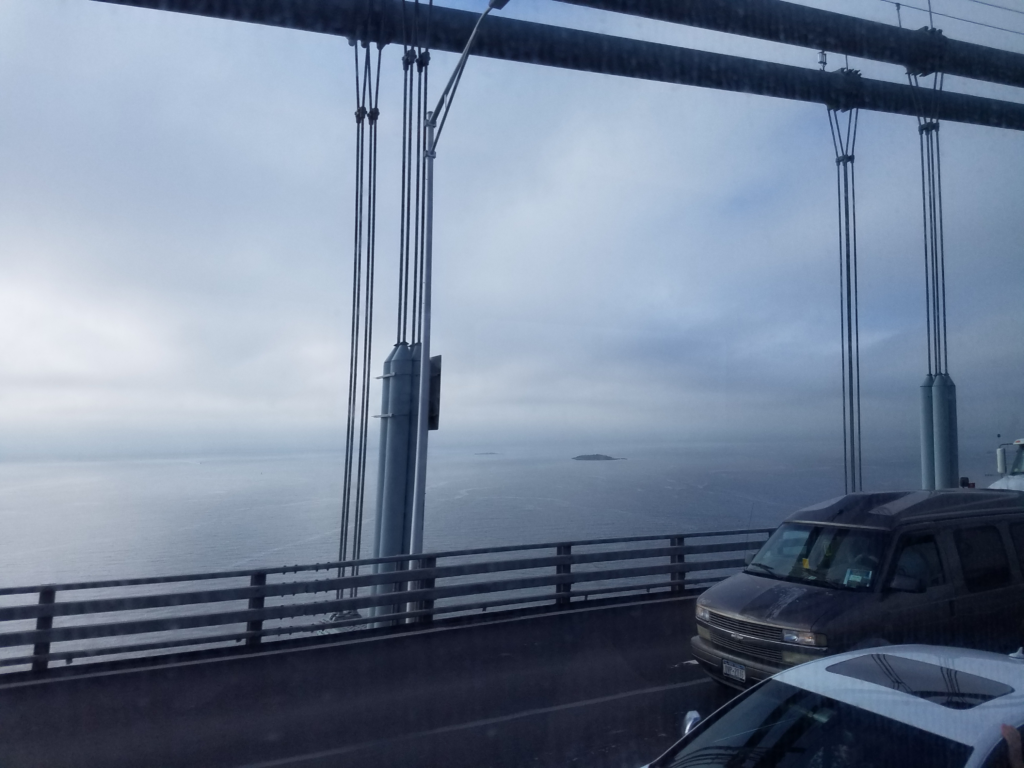The Verrazzano-Narrows Bridge is a bridge connecting two of New York City’s boroughs: Staten Island and Brooklyn. According to the Wikipedia page, its total length is 4,176 [m] and its height is 211 [m]. Undoubtedly, the bridge is an amazing engineering achievement that is one of the main symbols of New York City.
Before I start with the main topic of this post, please allow me to say a word or two about bridge toll expenses. I used to live on Staten Island and consequently, I remember well the splendid views of the Upper New York Bay and Lower New York Bay that can be observed from the upper deck of the bridge. Here are some photos that I photographed from the upper deck of the Verrazzano-Narrows Bridge in 2017 and 2018.



On the other hand, in order to drive across the bridge, it is necessary to pay expensive tolls. According to the Wikipedia page, a one-way toll in 2020 was $9.50. Even after the E-ZPass toll discount that is applicable to the Staten Island residents, we must admit that this is an expensive fee taking into account that the median household income of the New York City residents is approximately $60,000. Here it should be kept in mind that the apartment rental prices in New York City are astronomically high and a large portion of the household income is used to cover the rental expenses. I still do not think that such expensive tolls are really necessary and economically justified. I believe that there exists a more efficient and less expensive system for maintaining the bridge infrastructure. Besides the direct economical effect, there are also other negative effects that are caused by high bridge tolls. I will just mention a few examples. For example, I have noticed that working-class people on Staten Island tend to avoid driving to Brooklyn (as well as to New Jersey) due to expensive bridge tolls. Also, there is no subway line connecting Staten Island with other boroughs. This creates an atmosphere of isolation that a number of people on Staten Island experience. The tolls also have a negative economical impact on college students driving from other parts of the city. Finally, people from Brooklyn or New Jersey rarely visit Staten Island. This has a negative effect on the local economy on Staten Island. Okay, enough said about the bridge tolls.
This article is not about tolls. This article is about a YouTube video that came to my attention. The video can be seen below.
This video was filmed on November 30, 2020. It shows periodic (and apparently consistent) oscillations of the bridge structure. Apparently, the oscillations are caused by the wind of high intensity. Also, this phenomenon occurred almost at the end of the hurricane season. According to the Wikipedia page, the hurricane season lasts from June until November.
As a mechanical engineer, I find this video fascinating. After watching this video, I have been left with three impressions:
1.The oscillations are in the transverse direction.
2. The oscillations are followed by the periodic sound coming from the bridge structure. The sounds that the bridge structure is inducing reminds me of the sounds that a cello can produce.
3. I am almost 99.999 percent sure that the bridge designers were able to anticipate such high winds and to design the bridge structure such that it can withstand these oscillations. On the other hand, mechanical engineering students who took the fluid dynamics class probably remember the lesson on an aeroelastic flutter. Basically, it is suspected that this fluid-structure effect was the main cause of the collapse of the Tacoma Narrows Bridge in 1940. Here is a video about the collapse of the Tacoma Narrows Bridge:
In the case of the Tacoma Narrows Bridge, the oscillations were torsional. On the other hand, the wind-induced oscillations of the Verrazzano-Narrows Bridge were in the transverse direction. As I mentioned, I do not want to raise panic and to say that the Verrazzano Narrows bridge is unsafe. I am sure that mechanical and structural engineers designing bridges have learned the lessons from the collapse of the Tacoma Narrows Bridge and that these lessons are implemented into the design of the Verrazzano-Narrows Bridge. Here is a link to an amazing article I found about the collapse of the Tacoma Narrows bridge.
In any case, the Metropolitan Transportation Authority closed the bridge and they reopened it when the wind intensity decreased.
A YouTube video accompanying this video is given below.